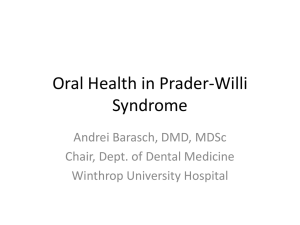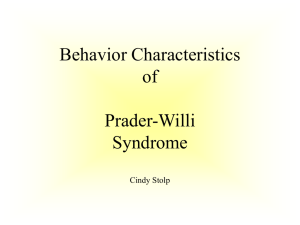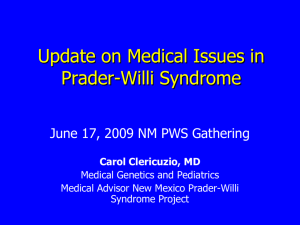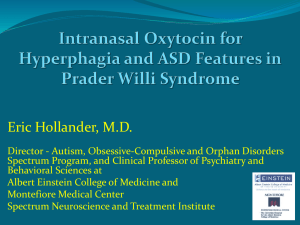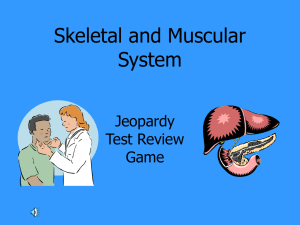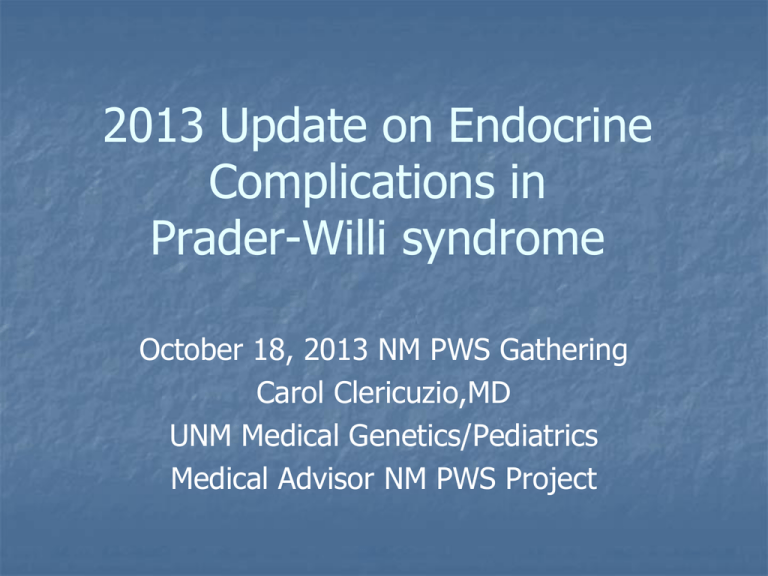
2013 Update on Endocrine
Complications in
Prader-Willi syndrome
October 18, 2013 NM PWS Gathering
Carol Clericuzio,MD
UNM Medical Genetics/Pediatrics
Medical Advisor NM PWS Project
Outline for Today’s Discussion
Brief overview of features of PWS
Hypothalamic dysfunction in PWS
Diagnosis and management of
endocrine abnormalities
Prader-Willi Syndrome
1/15,000 births
Neonatal hypotonia and
cryptorchidism
Hypothalamic dysfunction:
lack of satiety and subsequent
obesity; low sex hormones and
growth hormone
Cognitive and behavioral
differences
Cause is lack of expression of
paternal genes at 15q11-13
Prader-Willi Syndrome at Different Ages
Infancy: hypotonia,
feeding problems,
cryptorchidism, apnea,
check adrenals
Childhood: obesity, apnea
oppositional behaviors,
learning problems,
short stature Rx GH and
thyroid, check adrenals
Adulthood: type 2
DM, obstructive sleep
apnea, hypogonadism
Rx hormone replacement
Hypothalamus – part of the brain
• One of the most important
functions of the
hypothalamus is to link the
nervous system to the
endocrine via the pituitary
gland
• The endocrine system is a
system of glands, each of
which secretes different
types of hormones directly
into the bloodstream
PWS:
Problems with the
hypothalamus
Body thermostat
Regulation of appetite
Regulation of sleep
Controls endocrine system
Growth hormone releasing factor
Corticotropin releasing factor (adrenal gland)
Pubertal hormone releasing factors
Thyrotropin releasing factor (thyroid gland)
PWS: Growth hormone deficiency
in 40-100% of children
Effects of GH deficiency:
Short stature
Increased fat mass and
decreased lean mass (abnormal
body composition) – even
toddlers
Low insulin-like growth factor
(IGF-1: made by the liver in
response to GH)
Decreased GH secretion on
provocative tests
Benefits of GH therapy in
children with PWS
Lower body fat; increased muscle
mass
Better height
Better motor function
Possibly better cognition
Experts recommend starting GH prior to
onset of obesity: ~ 2 yo
Benefits of GH therapy in
adults with PWS
Benefits of childhood GH
may persist into adulthood:
lower fat
Prevalence of severe GH
deficiency in adults is 40-50%
GH use associated with higher glucose
Currently no consensus on GH testing
in adults, but GH is recommended
Risks of GH therapy
Contraindications per pharmaceutical
industry and clinical experts:
Severe obesity
Untreated severe obstructive sleep
apnea
Uncontrolled diabetes
Active cancer
Active psychosis
Risks of GH therapy
Concerns have been raised regarding:
Excessive elevations of IGF-1- may increase
tonsils & theoretical risk of cancer
Sleep disordered breathing
Scoliosis
Alterations in glucose metabolism
Sudden death
Currently recommend monitor IGF-1 levels
every 6-12 months
PWS: Sleep-disordered breathing
Obstructive sleep apnea
Sleep-related hypoxemia
Hypoventilation
Reduced ventilatory
response to low oxygen
and high CO2
Sleep and Breathing in Prader-Willi Syndrome
Nixon and Brouillette. Pediatric Pulmonology 34:209–217 (2002)
Risks of GH therapy
Sleep disordered breathing may
increase with GH therapy in some
studies
May be improved on other studies
Current guidelines to evaluate sleep
disordered breathing prior to
starting GH therapy
Pulmonary evaluation and
sleep studies on all patients
ENT referral if obstructive
sleep apnea, snoring,
enlarged tonsils/adenoids
Repeat sleep study within
first 3-6 months of starting
GH
PWS: Scoliosis and GH therapy
Scoliosis affects 30-80%
No effect of GH found on scoliosis
Consensus recommendation is
that prior to GH therapy, have
spine films and orthopedic referral
if necessary
After start of GH therapy, spine
film and/or orthopedic
assessment should be considered
if scoliosis progress a concern
PWS: Alteration in glucose
metabolism with GH
Concern is GH can increase insulin
resistance causing high blood
glucose
Pediatric: no problem with GH
therapy up to 4 years
Adult: minor increase in
glucose/insulin
Consensus recommendation:
monitor HgbA1C, glucose, insulin
and consider oral glucose tolerance
test for obesity, >12 yo, family
history of diabetes
PWS: Association of sudden death
with GH therapy
Has received a lot of attention: 20022006: 20 deaths reported in children on
GH but cause not been proven to be GH
Respiratory disorders are the most
common cause of death in PWS
When PWS deaths are looked at however,
there is no increase in those on GH
hormone
PWS: Association of sudden death
with GH therapy
However, 75% of deaths in GH group
occurred within 9 months of start of GH
Need close surveillance for any worsening
of sleep related breathing disorders during
first year of GH therapy
Sudden death may also be related to
central adrenal insufficiency – we
published a study showing small adrenals
PWS:
Problems with the
hypothalamus
Body thermostat
Regulation of appetite
Controls endocrine system
Growth hormone releasing factor
Corticotropin releasing factor (adrenal gland)
Pubertal hormone releasing factors
Thyrotropin releasing factor (thyroid gland)
Adrenal Gland Function
Adrenal glands sit on top of
the kidneys. They are
chiefly responsible for
regulating the stress
response through the
synthesis of cortisol.
Cortisol increases blood
pressure and blood sugar,
and reduces immune
responses
Cortisol deficiency can lead
to death if an individual is
stressed by surgery,
infection, dehydration, etc.
PWS and adrenal insufficiency
Frequency is unknown but it does occur
Due to problems with the hypothalamus
While deaths may be associated with
adrenal problems, especially during an
acute illness or after surgery, none of the
individuals were on GH
GH interferes with cortisol production so in
theory could contribute to a death
PWS and adrenal insufficiency
No consensus on appropriate evaluation
and management of PWS-associated
adrenal insufficiency
In New Mexico our pediatric
endocrinologists have recommended lowdose ACTH stimulation testing
Some experts recommend giving families
hydrocortisone to use at home in case of
severe illness and for surgeries
PWS:
Problems with the
hypothalamus
Body thermostat
Regulation of appetite
Controls endocrine system
Growth hormone releasing factor
Corticotropin releasing factor (adrenal gland)
Pubertal hormone releasing factors
Thyrotropin releasing factor (thyroid gland)
PWS: Hypogonadism
Decreased function of ovaries and testes
due to hypothalamic and pituitary
understimulation
Underdevelopment of genitals, delayed or
incomplete puberty and infertility in the
vast majority
Most males have undescended testes and
should have surgery by 1-2 yo
PWS: Replacement hormone treatment
for hypogonadism
Many individuals require
hormonal treatment for
induction, promotion or
maintenance of puberty
Benefits include improved
bone health, muscle mass
and possibly general wellbeing
Timing should reflect normal
puberty
PWS: Replacement hormone
treatment for hypogonadism
Sex hormone deficiency contributes to
low bone density in adults
Female sex hormones are taken orally
Male sex hormones can be delivered by
injection or patches and gels
PWS patients may have difficulty with
topical treatment due to skin irritation
and skin picking behaviors
PWS: Reproduction
No instances of paternity
Four cases of pregnancies and therefore
potential of fertility in females necessitates
discussion of sexuality and birth control at
the appropriate age
2 of the babies had Angelman
syndrome, a severe neurologic
disorder
PWS:
Problems with the
hypothalamus
Body thermostat
Regulation of appetite
Controls endocrine system
Growth hormone releasing factor
Corticotropin releasing factor (adrenal gland)
Pubertal hormone releasing factors
Thyrotropin releasing factor (thyroid gland)
PWS: Hypothyroidism
Reported in 20-30% of
children
Adult frequency is 2% =
general population
Experts recommend that
freeT4 and TSH be
screened in the first 3
months of life and annually
thereafter, especially if
receiving GH therapy
SUMMARY: PWS is characterized by
problems with the hypothalamus
Body thermostat
Regulation of appetite
Regulation of sleep
Controls endocrine system
Growth hormone releasing factor
Corticotropin releasing factor (adrenal gland)
Pubertal hormone releasing factors
Thyrotropin releasing factor (thyroid gland)
Questions?
Endocrine manifestations and management of Prader-Willi
syndrome. Emerick JE, Vogt KS. Int J Pediatr Endocrinol.
2013 Aug 21;2013(1):14.
Sleep disorders in PWS
Main feature
Associated features
Excessive daytime sleepiness
Increased nocturnal sleep
Behavioral problems
Issues related to learning and safety
Abnormalities of arousal
Reduced arousal to hypoxic and
hypercapnic stimuli during sleep
Sleep-disordered breathing
Obstructive sleep apnea
Sleep-related hypoxemia
Hypoventilation
Reduced ventilatory response to
hypoxia and hypercapnia
Sleep and Breathing in Prader-Willi Syndrome
Nixon and Brouillette. Pediatric Pulmonology 34:209–217 (2002)

